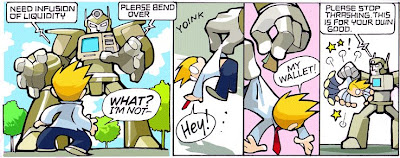
10/28/2008
10/27/2008
Film Nostalgia
My move from film-based to digital photography was not a pain-free one. Of course this would be true for any experienced photographer. Film and digital are different mediums. While they share some similarities, and in theory accomplish basically the same thing inside a camera body, their respective behaviors are different enough that the photographer has to learn a new set of rules for exposure and image processing. And then there's the need to become acquainted with digital technology itself, from PCs to RAW Image software. I'm no luddite, and I've been using PCs since forever. But trying to master digital photography forced me to learn more about how to use Adobe Photoshop than all the time spent dicking around with it in art school.
 After four years trying to figure this all out, I'm not convinced my digital photos are any better than my film-based photos. Part of the reason for this is that my transition to digital also marked a move into color photography. Up to that time, more than ninety percent of my photographs were taken with black and white film. I didn't have a lot of interest in shooting in color. But with the purchase of my first DSLR, I felt the time was right to dive into color photography. It was an opportunity to grow. I don't think I'm quite as accomplished with color as I am with black and white, and I've recently found myself missing the peculiar tonal qualities of Tri-X, HP5, and Neopan 1600.
After four years trying to figure this all out, I'm not convinced my digital photos are any better than my film-based photos. Part of the reason for this is that my transition to digital also marked a move into color photography. Up to that time, more than ninety percent of my photographs were taken with black and white film. I didn't have a lot of interest in shooting in color. But with the purchase of my first DSLR, I felt the time was right to dive into color photography. It was an opportunity to grow. I don't think I'm quite as accomplished with color as I am with black and white, and I've recently found myself missing the peculiar tonal qualities of Tri-X, HP5, and Neopan 1600.
None of this should be taken as sign to return to film, but as an indication of how much I still have to learn. I've recently updated all of my digital equipment, except for my computer, which makes working with 12 megapixel images something of a problem. Images shot since October on my photoblog are all on the new body. I'll be shooting digital for the foreseeable future.
What seems to have prompted my sudden desire to do a bit of film shooting were online discussions of a retro DSLR. I don't expect this to be manufactured anytime soon, but what I really want is a nice retro film body - one that doesn't require batteries to operate. I regret never purchasing the Nikon FM2 or FM3 when they were still being produced, and would love to acquire either one of these bodies as backup for occasional film shooting.
I have this sketchpad in my room which is still relatively brand new as I haven't touched it in over a year. Where did my motivation go?
That's enough personal digression for now.
 After four years trying to figure this all out, I'm not convinced my digital photos are any better than my film-based photos. Part of the reason for this is that my transition to digital also marked a move into color photography. Up to that time, more than ninety percent of my photographs were taken with black and white film. I didn't have a lot of interest in shooting in color. But with the purchase of my first DSLR, I felt the time was right to dive into color photography. It was an opportunity to grow. I don't think I'm quite as accomplished with color as I am with black and white, and I've recently found myself missing the peculiar tonal qualities of Tri-X, HP5, and Neopan 1600.
After four years trying to figure this all out, I'm not convinced my digital photos are any better than my film-based photos. Part of the reason for this is that my transition to digital also marked a move into color photography. Up to that time, more than ninety percent of my photographs were taken with black and white film. I didn't have a lot of interest in shooting in color. But with the purchase of my first DSLR, I felt the time was right to dive into color photography. It was an opportunity to grow. I don't think I'm quite as accomplished with color as I am with black and white, and I've recently found myself missing the peculiar tonal qualities of Tri-X, HP5, and Neopan 1600.None of this should be taken as sign to return to film, but as an indication of how much I still have to learn. I've recently updated all of my digital equipment, except for my computer, which makes working with 12 megapixel images something of a problem. Images shot since October on my photoblog are all on the new body. I'll be shooting digital for the foreseeable future.
What seems to have prompted my sudden desire to do a bit of film shooting were online discussions of a retro DSLR. I don't expect this to be manufactured anytime soon, but what I really want is a nice retro film body - one that doesn't require batteries to operate. I regret never purchasing the Nikon FM2 or FM3 when they were still being produced, and would love to acquire either one of these bodies as backup for occasional film shooting.
I have this sketchpad in my room which is still relatively brand new as I haven't touched it in over a year. Where did my motivation go?
That's enough personal digression for now.
10/24/2008
10/21/2008
Laika
I was too young to have lived through the era of the Space Race, but I do remember as a kid reading about the dog Laika, the first living being launched into space and orbit the planet. I was horrified that she was sent on a one way trip, and imagined her body left to decay in orbit, until finally burning-up in reentry. This was the kind of incomprehensible act of cruelty I thought grown-ups were only capable of. At the time her death was attributed to asphyxiation, which sounded bad enough. Only more recently was it revealed that she died prematurely due to a malfunction of the ships onboard systems.
Laika's story is the perfect hook to get children to read more about history. It's also an incredibly obvious example of how animals are often sacrificial offerings to the greater glory of man. The man in this case is Sergei Pavlovich Korolev - leader of the Soviet Union's space program. The book opens with him just released from the Gulag in the dead of winter. With no food and shelter, he keeps motivating himself to stay alive by repeating "I am a man of destiny. I will not die." Korolev's subsequent success in building the USSR's space program confirm his personal self-belief. But these also generate unrealistic higher expectations, which inexorably lead to him developing the project that would top all others - launching the world's first living space explorer.

While the repressive nature of the Soviet Union is alluded to, author Nick Abadzis concentrates on the personal rather than the political or scientific. As the dogs in the program were strays, there's no way to know the details of Kudryavka's (Laika's original name) background. So Abadzis fashions a fictional story full of the usual cliches about abandoned puppies, abusive masters, and sadistic dog catchers. It's clearly there to evoke compassion for the protagonist. But once she falls into the ownership of the government's space program, the story markedly improves. Several new characters take center stage: Oleg Georgivitch Gazenko, the person in charge of animal training, and his assistant Yelena Alexandrovna Dubrovsky. Both Oleg's personal dislike and resentment towards the overbearing Korolev, and Yelena's empathy towards her animal charges express doubt about the program's methods, and give voice to the otherwise mute test subjects. The stress caused by working on the project is further ramped up by the unspoken romantic tension between the two. In contrast Korolev, historically the most important figure, is comparatively less well developed.

Abadzis draws in a shorthand which, depending on readers tastes, is either somewhat incomplete and lacking, or refreshingly spontaneous. He has a tendency to cram as many panels as possible into the pages, especially during the talkative parts. This unfortunately can cramp his artwork, but when Abadzis opens-up the panels, the results can be extremely beautiful.
Laika is a work that wears its heart on its sleeve. It's not difficult to see where the author's sympathy lies. This could easily have wallowed in cheap sentimentality. But the historical realism of the setting, and the compelling characters of the second half of the story manage to keep the story grounded.
Laika's story is the perfect hook to get children to read more about history. It's also an incredibly obvious example of how animals are often sacrificial offerings to the greater glory of man. The man in this case is Sergei Pavlovich Korolev - leader of the Soviet Union's space program. The book opens with him just released from the Gulag in the dead of winter. With no food and shelter, he keeps motivating himself to stay alive by repeating "I am a man of destiny. I will not die." Korolev's subsequent success in building the USSR's space program confirm his personal self-belief. But these also generate unrealistic higher expectations, which inexorably lead to him developing the project that would top all others - launching the world's first living space explorer.

While the repressive nature of the Soviet Union is alluded to, author Nick Abadzis concentrates on the personal rather than the political or scientific. As the dogs in the program were strays, there's no way to know the details of Kudryavka's (Laika's original name) background. So Abadzis fashions a fictional story full of the usual cliches about abandoned puppies, abusive masters, and sadistic dog catchers. It's clearly there to evoke compassion for the protagonist. But once she falls into the ownership of the government's space program, the story markedly improves. Several new characters take center stage: Oleg Georgivitch Gazenko, the person in charge of animal training, and his assistant Yelena Alexandrovna Dubrovsky. Both Oleg's personal dislike and resentment towards the overbearing Korolev, and Yelena's empathy towards her animal charges express doubt about the program's methods, and give voice to the otherwise mute test subjects. The stress caused by working on the project is further ramped up by the unspoken romantic tension between the two. In contrast Korolev, historically the most important figure, is comparatively less well developed.

Abadzis draws in a shorthand which, depending on readers tastes, is either somewhat incomplete and lacking, or refreshingly spontaneous. He has a tendency to cram as many panels as possible into the pages, especially during the talkative parts. This unfortunately can cramp his artwork, but when Abadzis opens-up the panels, the results can be extremely beautiful.
Laika is a work that wears its heart on its sleeve. It's not difficult to see where the author's sympathy lies. This could easily have wallowed in cheap sentimentality. But the historical realism of the setting, and the compelling characters of the second half of the story manage to keep the story grounded.
10/17/2008
10/15/2008
There's Nothing New
Superman getting smacked complements Superman is a dick and Crying Superman - A long-standing pattern of super-heroic self-mockery. This could be seen as a variation of The Worf Effect.
10/05/2008
Kerry Edwards Wants Your Vote

...And he's not afraid to tell you what he really thinks about you.
From Overcompensating by Jeffrey Rowland.
10/01/2008
Farewell Minx

While the closure of the Minx line doesn't come as any surprise (Given DC's dismal track record for developing alternate publishing imprints) it's still a great shame that the end came a mere 18 months since it's launch. Minx was created to establish a niche within the expanding market for younger female readers found in bookstores. Despite the somewhat reactionary overtones in editor Shelly Bond's statements, it made perfect sense for a prominent publisher to make an effort to pursue this very important demographic so as not to get left behind. It was a significant sign that DC was sincerely looking beyond their aging direct market audience of largely adult males.
 There's been a lot of online commentary about why Minx failed. In the end, the Minx books, despite some favorable reviews, never gained much momentum, nor generated much enthusiasm with the intended audience. In hindsight DC didn't seem to have a firm enough grasp of the market, and didn't publish books that would draw in a large enough readership, to recoup their enormous marketing costs. Minx could arguably still prove to be a success if DC is willing to stick with the process of nurturing the imprint with a more modest budget while paying closer attention to the tastes of their readers. Publishing more talent with a proven track record for attracting female readers wouldn't hurt either. But they've chosen to pull the plug instead, thus ending the company's most high profile attempt to reach past the traditional comic book audience.
There's been a lot of online commentary about why Minx failed. In the end, the Minx books, despite some favorable reviews, never gained much momentum, nor generated much enthusiasm with the intended audience. In hindsight DC didn't seem to have a firm enough grasp of the market, and didn't publish books that would draw in a large enough readership, to recoup their enormous marketing costs. Minx could arguably still prove to be a success if DC is willing to stick with the process of nurturing the imprint with a more modest budget while paying closer attention to the tastes of their readers. Publishing more talent with a proven track record for attracting female readers wouldn't hurt either. But they've chosen to pull the plug instead, thus ending the company's most high profile attempt to reach past the traditional comic book audience.For more on the end of Minx, check out Tom Spurgeon and Christopher Butcher.
Subscribe to:
Posts (Atom)




